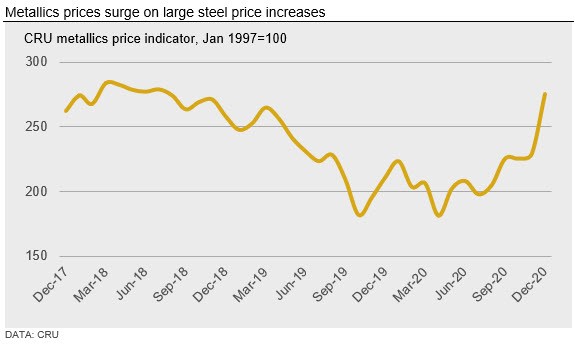Steel Products Prices North America

CRU: Steel Price Surge Causes Global Metallics Prices to Spike
Written by Ryan McKinley
December 8, 2020
By CRU Senior Analyst Ryan McKinley, from CRU’s Steel Metallics Monitor
The CRU metallics price indicator (CRUmpi) rose by 20.2% m/m in December to 275.2. This large increase was driven by a rapid acceleration in global finished steel pricing. Even with this large m/m increase for December, we again expect metallics prices to rise in January as steelmakers compete for material in increasingly tight markets.

The accelerated rate at which finished steel prices are rising across the world has caused metallics prices to spike in December. Because steel prices are so elevated, mills in most areas of the world are currently more concerned about securing material inflows than they are about input costs. As a result, they are aggressively bidding against one another to prevent potential output curtailments. For scrap, Chinese domestic prices have hit their highest point since 2012, while those in Brazil reached yet another record-high level. Meanwhile, U.S. prices rose by ~30% in a single month. Ore-based metallics are undergoing even larger increases m/m as traditional buyers compete with Chinese demand for material.
Strength in Chinese steel markets, in addition to adverse weather conditions, has driven scrap prices there to rise to an eight-year high. With relatively mild winter heating season restrictions this year, both EAF and integrated mill production (and by extension scrap demand) have been strong. Concurrently, winter weather has begun affecting scrap collection and transportation in the northern part of the country, and this too has helped support prices.
In other parts of Asia, a recovery in domestic scrap demand in Japan and reduced availability from the U.S. have tightened markets and led to higher prices. Vietnam-based scrap buyers witnessed a $55 /t m/m increase for HMS 1/2 80:20. Vietnamese steelmakers are keen to pass on the higher scrap costs to buyers through higher priced offers, and Vietnamese billet export prices are rising in line with other large m/m price increases in Asia. In contrast, steelmakers in Bangladesh are having a tougher time passing on higher scrap costs because of tepid steel demand conditions.
With Chinese steel producers focusing on their domestic markets, rising prices have provided openings for Turkish steel exporters in other parts of Asia. As prices for their exported products rise, producers in Turkey have also been willing to increase imported scrap prices. From the first week of November until the first week of December, Turkish scrap import prices rose by $67 /t CFR for HMS 1/2 80:20; the highest price level since May 2018.
Pressure from the international scrap market is adding to intense competition for material in the U.S. market between domestic mills. There, while higher prices are now helping spur scrap flows, weaker prices than expected by many in the market in prior months kept the pace of scrap collection slower than it might otherwise have been. As a result, shredded scrap prices have now risen to levels mirroring the peak of 2018’s price rally following the implementation of Section 232 tariffs.
While prices also increased in Europe, it was generally the weakest market we track with prices only rising by ~€20-30 /t m/m. Still, sellers there are hanging on to material in anticipation of yet more price hikes in January, especially given that pig iron prices there rose by more than $100 /t m/m in December.
Indeed, increases in the international pig iron market were substantial m/m. Chinese buyers remained in the market even as traditional buyers, who had largely shied away from the market due to high price levels, returned. In the U.S., bids became quite aggressive as buyers there sought to pull material away from China. Moreover, pig iron input costs have risen substantially in recent weeks and this has helped propel prices further still.
Outlook: Yet More Upside Price Pressure Ahead
Tightness in the finished steel market appears set to continue for the short term, meaning that competition for scrap will continue to be high. With finished steel prices also rising, mills across the globe are likely to accept a push by sellers looking for even higher prices in January (albeit at a smaller m/m increase). As such, we see essentially only upside risks for global metallics prices next month.

Request more information about this topic.
Learn more about CRU’s services at www.crugroup.com

Ryan McKinley
Read more from Ryan McKinleyLatest in Steel Products Prices North America

Nucor slows HRC price climb with $5/ton increase
After eight weeks of double-digit price increases on hot-rolled (HR) coil, Nucor slowed the price rise this week with an increase of $5 per short ton.

Domestic CRC prices surge ahead of imports
The price spread between stateside-produced CR and imports reached its widest margin in over a year.

Evraz raises plate prices $160/ton
Evraz North America (NA) has followed Nucor and SSAB with a plate price increase of its own: up $160 per short ton (st). The increase was effective immediately for all new orders of carbon, high-strength low-alloy, and normalized and quenched-and-tempered plate products, as well as for hot-rolled coil, the steelmaker said in a letter to […]

Nucor lifts HR coil to $820/ton
Nucor has increased its consumer spot price (CSP) for hot-rolled (HR) coil for a fourth consecutive week.

Nucor pushes HR spot price to $790/ton
Nucor increased its consumer spot price (CSP) for hot-rolled (HR) coil to $790 per short ton (st) on Monday, Feb. 10 – a $15/st bump vs. last week. The Charlotte, N.C.-based company has raised its weekly CSP by $40/st over the past three weeks after maintaining tags at $750/st since Nov. 12, according to SMU’s […]
